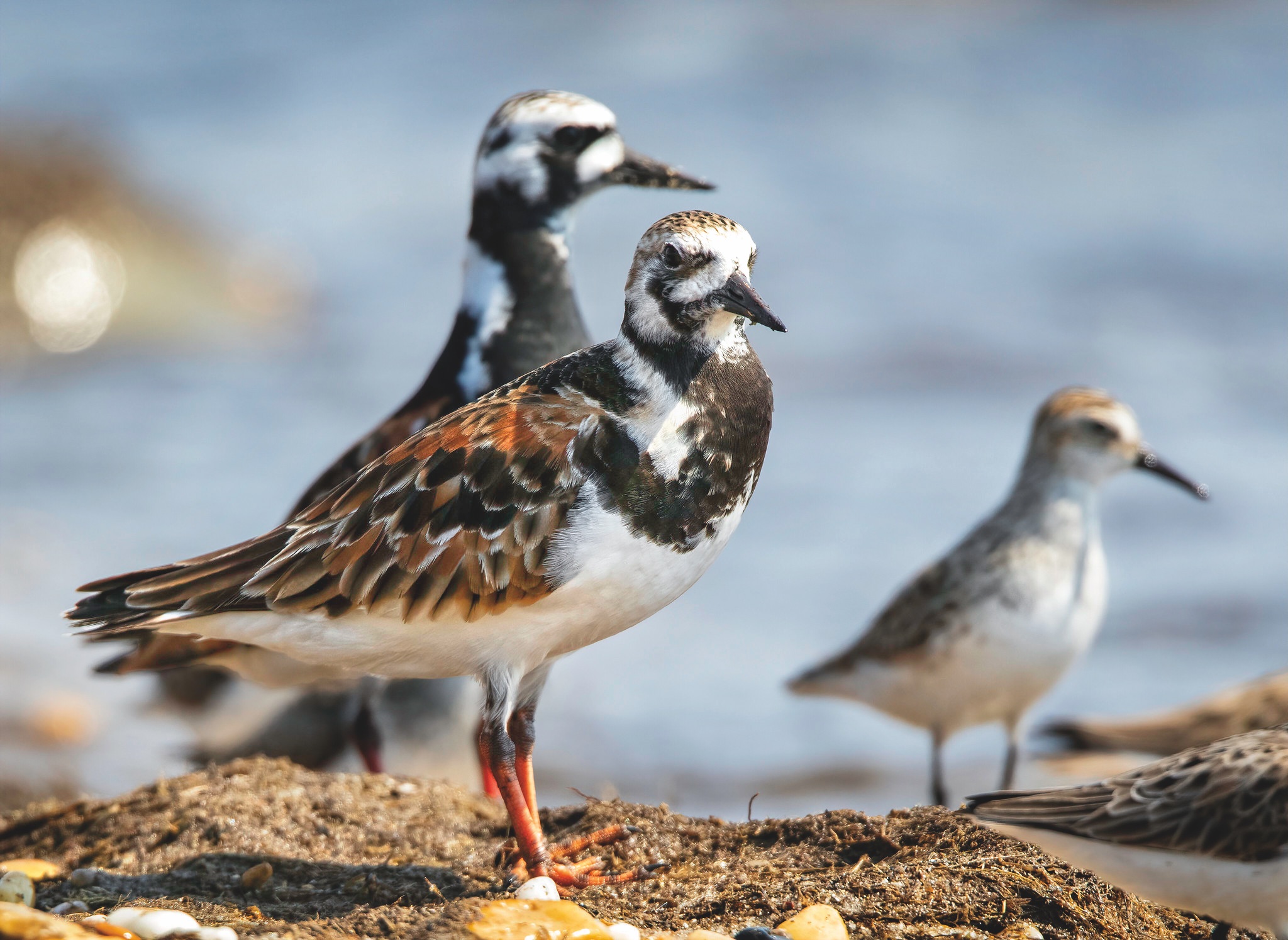
Migratory shorebirds flock to Delaware Bay beaches to feed on their way to northern breeding grounds
By Lynn R. Parks
Photograph by Deb Felmey
From the May 2022 issue

‘It’s not just people, yearning for surf and sun, who make annual treks to coastal Sussex. Migratory shorebirds — those stouthearted little creatures that travel thousands of miles every spring to reach their breeding grounds — include the beaches along Delaware Bay as a regular stop on their northward itineraries.
Up to 1 million shorebirds visit those beaches every spring, says Henrietta Bellman, a coastal avian biologist with the state’s Division of Fish & Wildlife. They represent as many as 30 species, including red knots, ruddy turnstones, semipalmated sandpipers, sanderlings and dunlins.
The birds typically arrive in late April and early May, Bellman says, with their populations peaking in mid-May. By the middle of June, they have left to continue their way north. Timing is everything in this journey: The shorebirds, exhausted and emaciated, arrive in Delaware at the same time that horseshoe crabs — like the birds, compelled by a centuries-old spring ritual — are crawling out of the bay to lay their eggs in the sand. The birds’ timely arrival along the Delaware Bay allows them “to forage during peak [horseshoe crab] spawning,” Bellman says.
At the height of the spawning season, horseshoe crabs deposit on bay beaches billions of tiny olive-green eggs, the perfect meal for hungry migrators. Though the state discontinued its horseshoe crab egg counts in 2013, “it’s widely known that at certain Delaware Bayshore locations, eggs can cover large portions of the beach,” says Department of Natural Resources and Environmental Control spokesman Michael Globetti. He points to the 2010 study, when state workers at Mispillion Harbor (the site of the DuPont Nature Center where the Mispillion River spills into Delaware Bay) counted more than 750,000 eggs per square meter of sand. That’s more than 3 billion eggs for every acre of beach.
The birds gorge themselves on the protein-rich eggs over a period of about 10 days, doubling their weight and gaining the strength needed to complete their trip northward and successfully breed.
“This is a really unique thing for Delaware,” says Jean Woods, an ornithologist and longtime volunteer with the Delaware Shorebird Project, a monitoring and research program operated by the state. “The Delaware Bay is the main place where horseshoe crabs come and breed in such large numbers ... that and the shorebird visits are really tied together. The birds don’t do this sort of thing anywhere else in the world.”
Woods, who grew up in Washington, D.C., and whose family visited Delaware and Maryland beaches when she was young, recalls being amazed to see shorebirds in such numbers when she started volunteering with the Shorebird Project. “I’d seen big flocks of shorebirds before, numbering in the thousands,” she says. “But during the migration, we get flocks that are in the hundreds of thousands. The magnitude of the whole thing — the sheer number of the birds — is amazing.”
‘Threatened’ red knot
The Delaware Shorebird Project was started in 1997, part of a global effort to mitigate threats to migratory shorebirds. Those threats include shoreline erosion, coastal urbanization and increased disturbance from humans, Bellman says. The effects of climate change, including sea level rise, changes to weather patterns and alterations in availability of prey, are making survival difficult for the birds. And hunting, despite various laws that ban it, is still a problem. The number of shorebirds killed by hunters in Suriname, along the northern coast of South America, for example, is estimated to be in the tens of thousands annually.
“In recent decades, this amazing natural cycle is being disrupted,” says the shorebird project website. The project is working to pinpoint why the bird populations are going down, Woods adds.
Ruddy turnstones, sanderlings and semipalmated sandpipers, all of which are declining in number, are three of the four species on which the project focuses. They are also identified in the Delaware Wildlife Action Plan as having “Tier 1” status among the state’s species of greatest conservation need. Tier 1 animals include the rarest species locally as well as globally, as well as those whose populations are under threat from climate change.
The fourth species that the project focuses on is a shorebird that most captures the public’s imagination, largely because of its extraordinary 10,000-mile annual migration. Also identified as a Tier 1 species, this bird is one of the six subspecies of the red knot, and one of three that reside in the Western Hemisphere.
Large populations of Calidris canutus rufa, which Woods describes as “beautiful,” winter in Tierra del Fuego, an island group off the southern tip of South America, and refuel at Delaware Bay beaches before going on to breeding grounds in the central Canadian Arctic tundra.
After hatching and caring for their young, the birds head south again, leaving the Arctic beginning in mid-July. In the U.S., fall stopover sites include the coasts of Massachusetts, New Jersey and Georgia.
Those annual migrations add up to a lot of miles: A rufa red knot (the species that migrates through our area) that was banded in May 1987 by Delaware Shorebird Project volunteers was seen again in Delaware in May 2000. During those 13 years, the bird had flown 242,350 miles, about 3,000 miles greater than the distance from the earth to the moon. This is especially astonishing given the size of the bird — about that of a robin — and its wingspan: just 20 inches.
Rufa populations in the United States were decimated in the 1800s by commercial hunting, for sport as well as for food, Bellman says. The Migratory Bird Treaty Act, signed into law in 1918, put an end to that, and the bird’s populations rebounded.
“But in the 20th century, coastal development and unregulated overharvest of horseshoe crabs took a toll,” Bellman says. From 1980 to 2010, rufa populations in Tierra del Fuego declined by about 75 percent, with a corresponding drop in the Delaware Bay migrating population.
In 2015, the rufa red knot was determined by the federal government to be “threatened” under the U.S. Endangered Species Act. (A species so labeled is likely to become endangered “within the foreseeable future.”)
Conservation measures — including Atlantic States Marine Fisheries Commission regulations limiting the harvest of Delaware Bay horseshoe crabs to 500,000 and banning the harvest of female crabs altogether — are credited with helping to stabilize the rufa population. (New Jersey has banned horseshoe crab harvesting completely.)
Today, about 45,000 rufa red knots visit Delaware Bay beaches every spring, a number that has remained stable for about a decade. That represents from 50 percent to 80 percent of the world’s population of the migrating bird, Bellman says.
‘Squabbling’ ruddy turnstone
The ruddy turnstone, short and squat and distinctive with its black bib, white belly and orange legs, is one of only two turnstones in the world. It can be found nearly across the globe; the birds that stop over along the Delaware Bay in May and June breed in the northern Arctic and winter in Central and South America. Ruddy’s cousin, the black turnstone, breeds in Alaska and winters along the West Coast of North America.
True to their name, turnstones use their beaks to flip over stones and debris to reveal prey, which includes insects, marine invertebrates, and, for those that spend a week or so on the Delaware shore, horseshoe crab eggs.
Coastal avian specialist Bellman admits to a special fondness for these birds. “I do particularly like watching them as they literally flip stones looking for prey and often get into noisy scraps with one another on the shoreline,” she says.
Similarly, ornithologist Woods calls the ruddy turnstone her favorite shorebird — for the moment at least. “They have a real attitude while here in Delaware, spending lots of time squabbling with each other and giving their distinctive rattle call while doing so,” she notes. “They also like to dig down in the sand to find eggs, which none of the other species really does.”
The ruddy turnstone is considered to be of “least concern,” according to a list of threatened species compiled by the International Union for Conservation of Nature. However, they face the same risks — including climate change and habitat destruction — faced by other migratory shorebirds. The species is designated as a high conservation concern by the Western Hemisphere Shorebird Reserve Network and the U.S. Shorebird Conservation Plan.
Semipalmated sandpiper
The semipalmated sandpiper — like sanderlings, one of many species of sandpipers — gets its name from the short webs between its toes (“palmated” means webbed). The diminutive Calidris pusilla, less than 6 inches long and weighing around 1 ounce, is known to fly nonstop from its breeding grounds in southeastern Canada and the northeastern United States to its winter home along the northern shores of South America. That direct flight, across the Atlantic, can be as long as 2,500 miles.
Although the species’ global population numbers in the millions, it is suspected to have declined by nearly 30 percent over three recent generations (22 years). Because of those declining numbers, the semipalmated sandpiper is listed as near-threatened by the International Union for Conservation of Nature.
Scientists estimate that about 60 percent of the total population of semipalmated sandpipers stops along Delaware Bay to feed on crab eggs.
Sanderling
The sanderling is a sandpiper that breeds in the high Arctic tundra. Its name comes from the Old English “sand-yroling,” or sand-plowman.
During non-breeding season, sanderlings are found on nearly all sandy beaches around the world. They are the small (about 7 inches in length, weighing about 3.5 ounces) birds that beachgoers see running back and forth on the sand, in sync with the waves, searching for small crabs and invertebrates.
Throughout its range, the sanderling is considered of “least concern” by the International Union for Conservation of Nature.
Ornithologist and Delaware Shorebird Project volunteer Jean Woods believes that the sanderling and Delaware’s other migratory shorebirds are worthy of protection. “Animals and plants have a place in this world,” she says. “I tend to feel that, unfortunately, most of the causes of species declining can be traced back to something that people are doing, and I don’t really feel that that’s OK.
“Everything in the natural world is tightly linked together. And when you start taking out pieces, I’m kind of worried that if you take out enough pieces, then what happens? It’s a slippery slope: All the red knots vanish, then we don’t have cardinals, robins or blue jays. Do we really want to live in a world where all these birds have vanished?”



